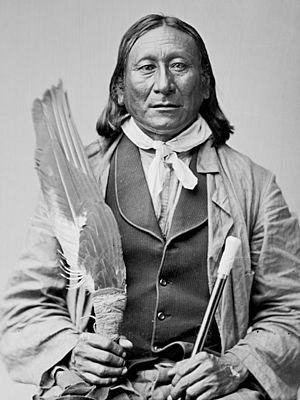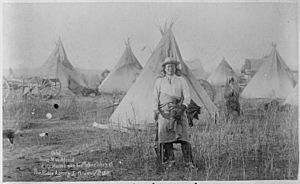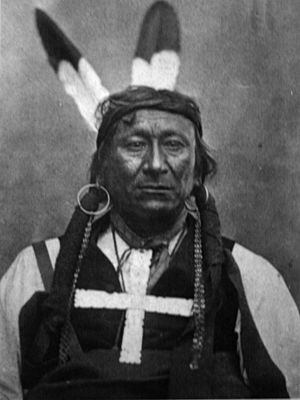Young Man Afraid of His Horses facts for kids
Quick facts for kids
Young-Man-Afraid-of-His-Horses
|
|
|---|---|
| Tȟašúŋke Kȟokípȟapi, also translated as His-Horses-Are-Afraid and They-Fear-Even-His-Horse | |

Young-Man-Afraid-of-His-Horses, 1884
|
|
| Oglala Sioux chief leader | |
| Preceded by | Old Man Afraid of His Horse |
| Personal details | |
| Born | 1836 |
| Died | July 13, 1893 (aged 56–57) near Newcastle, Wyoming, United States |
| Resting place | Makansan Presbyterian Cemetery near Oglala, South Dakota |
| Parent | Chief Old Man Afraid of His Horse (1808–1889) |
| Known for | Fought under Red Cloud in Red Cloud's War; negotiator for the Sioux Nation after the Wounded Knee Massacre; served on delegations to Washington, D.C. |
Young-Man-Afraid-of-His-Horses (born 1836 – died July 13, 1893) was an important leader of the Oglala Sioux people. His name in his native language was Tȟašúŋke Kȟokípȟapi. This name is often misunderstood. It actually means "They fear his horse" or "His horse is feared". This meant that he was so brave in battle that even the sight of his horse would make enemies afraid.
He is remembered for his role in Red Cloud's War. He also worked as a negotiator for the Sioux Nation after the terrible Wounded Knee Massacre. Young-Man-Afraid-of-His-Horses traveled to Washington, D.C. many times to speak for his people.
Contents
Early Life and Family
Young-Man-Afraid-of-His-Horses was born around 1836. He came from a respected family of Oglala leaders. His father, also a chief, was known as Old Man Afraid of His Horse. Young-Man-Afraid-of-His-Horses was the fourth person in his family to carry this important name.
His father, Old Man Afraid of His Horse, was a leader of the Hunkpatila band of Oglala. Around 1870, as times became uncertain, his father passed most of his leadership duties to Young-Man-Afraid-of-His-Horses. In 1871, the Oglala people divided over the creation of the Great Sioux Reservation. Young-Man-Afraid-of-His-Horses and his followers settled at the Pine Ridge Agency. His group became known as the Payabya band.
Becoming a Leader
The brutal Sand Creek massacre in 1864 led to war in the South Platte River Valley. The Cheyenne, Lakota, and Arapaho fought back against the attack on their peaceful village. Young-Man-Afraid-of-His-Horses became a key Oglala warrior during these battles.
In 1866, the U.S. Army started building forts along the Bozeman Trail. This angered the Lakota and Cheyenne because these forts were on their hunting grounds. U.S. officials invited leaders to a meeting at Fort Laramie. But during the meeting, soldiers arrived to build Fort Phil Kearny without the Lakota's permission. This made leaders like Old Man Afraid of His Horse and Red Cloud very angry. Most of the Lakota left the meeting.
These events led to Red Cloud's War from 1866 to 1868. This was the only Native American war where the United States was defeated. Young-Man-Afraid-of-His-Horses was a very important war leader in this conflict.
He played a big part in the Lakota victory at the Battle of the Hundred Slain. At the Wagon Box Fight in 1867, he and Crazy Horse led the Lakota and Cheyenne warriors. In 1868, the Oglala council gave Young-Man-Afraid-of-His-Horses a high honor. He became one of the four head "shirtwearers," or protectors of the people. He was the only one of these four who kept his special shirt until his death.
Protecting His People and Culture
Young-Man-Afraid-of-His-Horses and his father signed the Treaty of Fort Laramie in 1868. This treaty ended Red Cloud's War. However, they did not plan to leave their hunting grounds right away. White settlers had driven away most of the buffalo. By the early 1870s, the Hunkpatila people faced hunger. By late 1871, Young-Man-Afraid-of-His-Horses, his father, and Red Cloud led their followers to the Red Cloud Agency.
After settling on the Great Sioux Reservation, Young-Man-Afraid-of-His-Horses worked hard to protect his people's land and culture. He tried to find peaceful ways to deal with the U.S. government. He asked for fair payment for the loss of the Black Hills and the buffalo. He went on several trips to Washington, D.C., to ask for better treatment. He also helped his people adjust to life on the reservation. For three years, he was the President of the Pine Ridge Board of Councilmen.
Young-Man-Afraid-of-His-Horses resisted the government's push for his tribe to become farmers. He grew a small garden and raised some cattle, horses, and turkeys. He also often left the reservation to hunt and travel the prairie. During this time, he made peace with the Crow Nation, who were once enemies. He visited them regularly for the rest of his life. Even though he worked with the whites, he remained a strong traditional Lakota leader. He only spoke his native language and had two wives. He fought hard to help his people keep their lands in the 1880s.
As the government tried to break up the Great Sioux Reservation, Young-Man-Afraid-of-His-Horses worked with Red Cloud again. They, along with Little Wound and Old Man Afraid of His Horse, fought against Congress's efforts to take Lakota land. Although they stopped the plan at Pine Ridge, the land was eventually taken.
The loss of land and a cut in food supplies made life very hard for the Lakota. A drought in 1890 caused many cattle to die. Hunger and disease spread. Young-Man-Afraid-of-His-Horses knew the whites had destroyed the buffalo and surrounded his people. He felt sad about their suffering. He often spoke about how much he missed the old days:
There was a time when we did not have to assume the character of beggars ... Then we were free to go where we pleased while now we are penned up like so many cattle ... There was a time when the buffalo covered our plains and furnished us with all the meat we needed. Now they are gone, wantonly destroyed by the white man and we are obliged to beg for something to take their place.
The Ghost Dance and Peace Efforts

When people are very desperate, new religious movements can spread quickly. The Ghost Dance promised to reunite people with loved ones, bring back the buffalo, and unite all Native Americans. Leaders like Young-Man-Afraid-of-His-Horses sent people to Nevada to learn about the Ghost Dance. The new religion came to Pine Ridge in March 1890. Many Oglala became strong followers, but Young-Man-Afraid-of-His-Horses never joined the Ghost Dance. In fact, he was against it.
Tensions grew, and government officials sent troops to Pine Ridge. In late 1890, Young-Man-Afraid-of-His-Horses took his band off the reservation for a long hunt and a visit to the Crow people. Because of this, he was not involved in the killing of Sitting Bull or the terrible Wounded Knee Massacre.
General Nelson A. Miles asked Young-Man-Afraid-of-His-Horses to help calm the "hostile" Lakota in the Badlands. When he heard about the massacre, Young-Man-Afraid-of-His-Horses agreed to return to Pine Ridge. He went to the hostile camp twice. On January 14, 1891, he brought Ghost Dance leaders like Little Wound and Two Strike to meet General Miles. Within 36 hours, Young-Man-Afraid-of-His-Horses had helped end the conflict. However, some former Ghost Dancers burned his house and stole his livestock because of his peacemaking efforts.
Later, a young Sicangu Lakota named Plenty Horse killed an officer. A few days later, cowboys attacked a small group from Young-Man-Afraid-of-His-Horses' band. This group, led by Few Tails, was unarmed and hunting. Few Tails was killed, and his wife was shot. This unprovoked murder made Young-Man-Afraid-of-His-Horses very angry. General Miles asked him to help arrest the killers. Young-Man-Afraid-of-His-Horses refused, saying:
No, I will not surrender them: but if you will bring the white men who killed Few Tails, I will bring the Indians who killed the white soldier and the herder; and right out here in front of your tepee I will have my young men shoot the Indians and you have your soldiers shoot the white men, and then we will be done with the whole business; They were all bad men.
General Miles did not accept this offer.
Death
In July 1893, Young-Man-Afraid-of-His-Horses left the reservation to visit the Crow people. On July 13, near Newcastle, Wyoming, he had a heart attack or stroke and died at age 56. He was buried with military honors at the cemetery on the Pine Ridge Agency.


